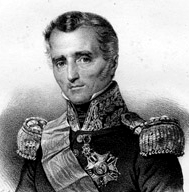General Sylvain Charles Valée

Born: December 17, 1773
Place of Birth: Brienne-le-Château, Aube, France
Died: August 15, 1846
Place of Death: Paris, France
Arc de Triomphe: VALEE on the west pillar
Pronunciation:
A career officer, Sylvain Charles Valée entered the artillery school of Châlons in September of 1792 as a sous-lieutenant. The next year he left the school as a lieutenant assigned to the 1st Foot Artillery and in 1794 he served with the Army of the Sambre and Meuse. Valée received a promotion to capitaine in the 3rd Horse Artillery in 1795, and then in 1796 he served at the crossing of the Rhine at Neuwied and at the Battle of Wurzburg. In 1799 he joined the Army of the Rhine, and the following year he served at Engen before taking command of the artillery of Decaen's division and then fighting at Hohenlinden.
During the peace that followed, Valée was promoted to chef d'escadron in the 5th Horse Artillery in 1802 and then in 1803 he was sent to the Army of the Coasts of the Ocean. When the Grande Armée marched to war in 1805, Valée served as inspector general of the train of the artillery reserve. In this position he participated at Ulm and Austerlitz in 1805 and then at Jena in 1806. In November of 1806 Valée replaced Senarmont as chief of staff of artillery of the Grande Armée and two months later he was promoted to colonel. The following month he took command of the 1st Foot Artillery and he led them through the remainder of the campaigns of 1807.
In 1808 Colonel Valée was sent to the Army of Spain where he became director of the siege artillery park to serve under Marshal Lannes at the siege of Saragossa. In 1809 he received a promotion to général de brigade and he took command of the artillery of III Corps under General Suchet. The following year Valée served at a number of sieges including Lérida, Mequinenza, and Tortosa. That year he was also named commander of the artillery school of Douai, though he remained in Spain despite this appointment. 1811 was another busy year for Valée for he was named a Baron of the Empire and promoted to général de division, and he served at the siege of Tarragona. At the end of the year he took part in the siege of Valencia and then in 1812 he served at the siege of Peniscola. As the French continued to struggle in Spain, Valée prepared Catalonia and Valencia for defense. When the French were finally forced out of the Spanish Peninsula, Valée successfully brought the artillery park back to France instead of losing the guns and equipment. For this achievement, he was named a Count of the Empire.
After Napoleon's abdication, the Bourbons continued to employ General Valée at Strasbourg. Nevertheless he rallied to Napoleon in 1815 when Napoleon resumed power for the Hundred Days. Valée was named deputy commander of the artillery reserve at Vincennes and he also commanded the artillery defending Paris in June. After Napoleon's second abdication, Valée did not incur the wrath of the Bourbons, instead being appointed to a committee to reorganize the artillery and to a council of war to judge Lefebvre-Desnouettes.
In 1822 Valée joined the board of the École Polytechnique and he was also named inspector general of the central service of artillery. In 1827 he officially proposed a new artillery system and directed a series of tests on it at the camp of Saint-Omer. In 1830 Valée was named a Peer of France but this was annulled by article 68 of the charter of 1830. Unemployed after the July Revolution, in 1834 he was reemployed by the army and in 1835 he was named director of service of powders and saltpeters and a Peer of France. In 1837 Valée was sent to Algeria to command the artillery and he served as part of the force sent to take Constantine. When the commander-in-chief Damrémont was killed in October, Valée took command of the army and the next day directed them to successfully take Constantine by assault. A few weeks later he was named governor general of Algeria and in November he was appointed a Marshal of France. While serving as governor general Valée pacified the province of Constantine and at the end of 1839 he beat Abd-el-Kader at Boufarik. In 1840 he occupied Cherchell, defeated Abd-el-Kader at the pass of Mouzaïa, and then occupied Médéah and Milianah. Valée continued to serve in this role until the end of 1840 when he was replaced by Bugeaud. He returned to Paris where he presided over a commission of fortifications of Paris and then retired to private life in 1843.
Bibliography
Updated March 2025
© Nathan D. Jensen